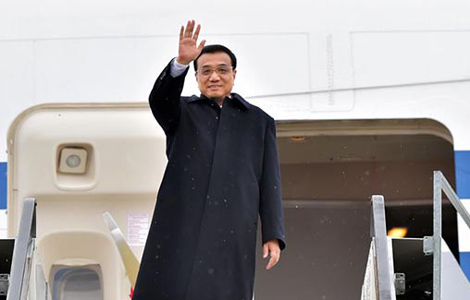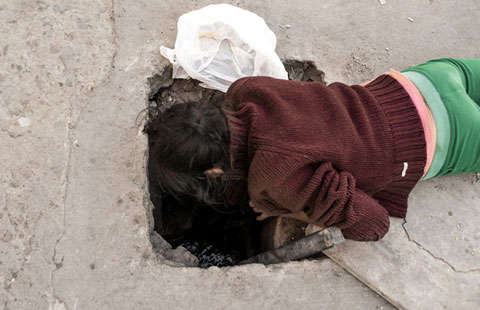China calling
Updated: 2015-01-21 07:10
By Yang Feiyue(China Daily)
|
||||||||
Asian giant gears up to pull out all stops to halt the fall in inbound tourism, Yang Feiyue reports.
China will step up efforts to reverse the decline in the number of inbound tourists.
A total of 33,500 modern public restrooms will be built nationwide covering scenic spots, transportation hubs and entertainment facilities in the next three years, as part of the country's efforts to improve tourism infrastructure.
A well-developed high-speed rail system across Central China and the country's western areas will likely be developed in the future, with rail links - between cities such as Xuzhou and Lanzhou, and those connecting Shanghai and Kunming - expected to be operationalized this year, officials say.
Analysts also suggest the beefing up of online content related to China's tourism since most international travelers these days only seek travel information on the web.
"We should pay attention to social networking software, use languages that suit international tourists and upgrade China's tourism image in a systematic and long-term manner," Zhu Hua, director general of the Fujian tourism bureau, said at the fourth China Tourism Industry Conference held in eastern China's Nanchang city, Jiangxi province, on Jan 13-14.
She says the country should build large-scale travel cooperation, exchange, information and financing platforms and integrate resources nationwide to boost the country's tourism. A think tank for the sector was also launched at the conference, with the aim of halting the fall in inbound tourism.
A joint effort between the National Public Opinion Poll Lab of the Chinese Academy of Social Sciences and the Beijing-based paper China Travel News, the new think tank will probe the deep-rooted reasons behind the decline in China's inbound tourism and make recommendations to solve the problems, says Liu Zhiming, chief analyst for the National Public Opinion Poll Lab.
"The think tank will conduct research on 23 countries and regions worldwide, all of which are major sources of inbound tourists to China," Liu says.
Twenty-six million foreign tourists visited China in 2014, and half of them were on business trips, according to him.
International language and modern methods should be applied to tell traditional Chinese cultural and historical stories and woo foreign guests, says Song Rui, director of the tourism research center at CASS.
The number of inbound tourists who took sightseeing tours stood at roughly 6.5 million from January to September in 2014, down 13.8 percent when compared with the figure during the same period in 2013, according to the China National Tourism Administration.
According to Liu, the reasons behind slowing inbound tourism to China are complex.
Many foreign businesses have moved out of China in the past two years, resulting in a reduction in the number of business travelers from abroad, he says.
"China's inbound tourism is expected to hit bottom by the end of 2015," Liu predicts. "It may start to rebound only from 2016."
Air pollution, food and travel safety are among major reasons that keep tourists from neighboring countries, such as Japan, South Korea and Singapore, from choosing China as their travel destination, he adds.
Costs are, for the most part, to blame for discouraging tourists from Europe, America and Africa.
It costs about $2,000 for these long-distance travelers to China, when they can spend less on trips to major European tourist attractions closer to home.
Still, the key reason for the decline in inbound tourism is the slipping national image of China, Liu says.
Foreign media focus on the country's pollution, wealth gap, corruption and public security problems, appear to have caused a change in their people's perception of China.
Cai Jiacheng, deputy director of the information center of the tourism administration, says high-priced but low-value tourism products that lack competitiveness are to blame for the sluggish trade. The websites of many tourism administrations and scenic spots are "impractical and poorly maintained".
The international financial crisis and RMB appreciation, are among the factors that contributed to the downturn trend in China's inbound tourism, says Zhu.
In an international study prior to its official launch earlier this month, the new think tank found that foreigners still have a keen interest in traveling to China, and there's a huge potential for growth in the number of inbound tourists. But the challenges remain.
For instance, many foreign tourists surveyed expressed a lack of desire to travel to China in the next three years citing various reasons. In addition, China's inbound tourism market faces competition from neighboring countries, such as Japan, which has witnessed significant growth of its inbound tourism market.
Liu is optimistic though. He believes China can expect a quadruple growth in inbound tourism in the future, considering the country's abundant tourism resources.
Contact the writer at yangfeiyue@chinadaily.com.cn
(China Daily 01/21/2015 page24)
- Chinese premier arrives in Switzerland for Davos forum, working visit
- Obama to focus on middle class in State of Union address
- Chinese naval escort fleet visits Germany
- At least 4 killed in clashes in Congo
- UN condemns escalating attacks by Boko Haram
- Israel steps up security for possible Syria airstrike

 Chinese premier arrives in Switzerland for Davos forum, working visit
Chinese premier arrives in Switzerland for Davos forum, working visit
 7 things you may not know about Major Cold
7 things you may not know about Major Cold
 After the American dream breaks
After the American dream breaks
 300 libraries for China's countryside
300 libraries for China's countryside
 New York Philharmonic to celebrate Lunar New Year
New York Philharmonic to celebrate Lunar New Year
 Long Island collectors display Chinese art then and now
Long Island collectors display Chinese art then and now
 China's Li Na expecting first baby
China's Li Na expecting first baby
 Bank, Rockets help out school
Bank, Rockets help out school
Most Viewed
Editor's Picks

|

|

|

|

|

|
Today's Top News
Foreign oil wells attract Chinese investors
Chinese premier arrives in Switzerland for Davos forum, working visit
Obama to focus on middle class in State of Union address
Drive against terrorism in Xinjiang shows result
Xiaomi feeling 'phabulous' about new phablet
Economic growth edges to 24-year low of 7.4%
Opening round of Iran sanctions fight kicks off in Senate
China: Pet-food products removal not a judgment
US Weekly

|

|







